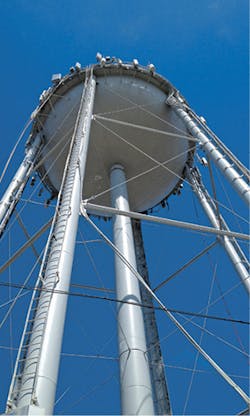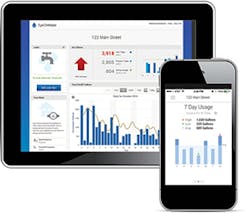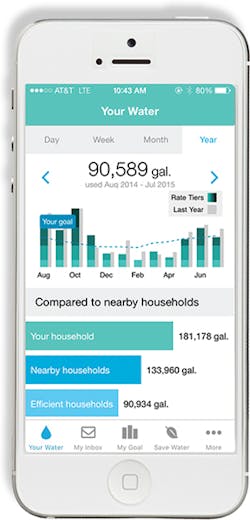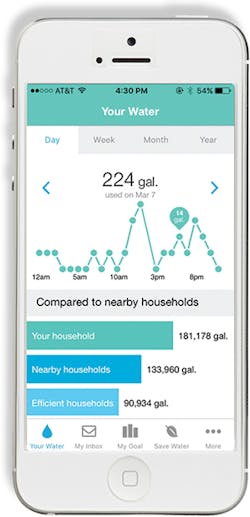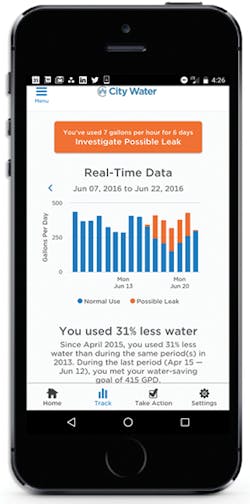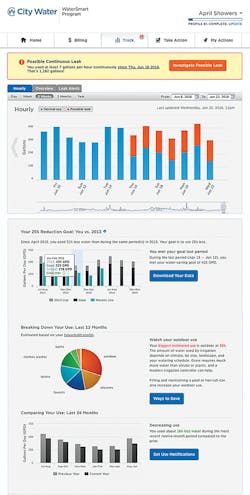In recent years, municipalities and utility companies have endeavored to learn how to capture, access, and manage data provided by Advanced Metering Infrastructure (AMI). Now, they have another challenge: Teach the public about the benefits of AMI.
“There’s confusion about what AMI is,” postulates Robb Barnitt, CEO of Dropcountr.com, a software company that partners with utilities to better manage data. “There are misconceptions, fears, and knee-jerk reactions.”
Customers are concerned with everything from higher costs to privacy and health concerns, states Jeff Lipton, director of marketing for WaterSmart.
AMI helps utilities increase efficiency and improve operations.
Dan Pinney, senior director of global water marketing at Sensus, says there are occasionally questions about privacy and safety, but that they are quickly put to rest once customers learn the facts about AMI.
“The new technology does not negatively affect health or privacy,” emphasizes Pinney. “In fact, overall health will be improved and privacy enhanced by replacing vehicles and manual visits to homes with environmentally clean radio communication.” The wireless portions of the system operate according to Federal Communications Commission rules, and do not interfere with other radio frequencies in the area.
Allaying health concerns, he adds, “The transmitters use one-quarter of the power of a cellphone. The amount of exposure to radio waves decreases with the square of the distance from the source. Exposure to radio waves from smart meters is absolutely tiny compared to cellphones.”
John Fillinger, director of utility marketing for Badger Meter, thinks that one of the biggest misconceptions about AMI is that it needs to be complicated and resource-intensive. “Today, AMI systems and the analytics software that goes with them are offered in managed solution models that put the responsibility of managing the communications network and hosting the secure software squarely on the metering vendor. Instead of needing to manage communications networks and infrastructure, a managed solution model frees the utility to do what it does best: deliver high-quality water to its customers. Further, newer cellular-based communications products can eliminate the need for the utility to own any communications infrastructure at all.”
Badger Meter’s EyeOnWater user interface
LEAKY LOSSES
Lipton says customers “do not generally see how any of these investments can help them directly.” It’s likely that they are confusing AMI with Automatic Meter Reading (AMR). AMR is a walk-by, drive-by, or fixed-network system that reads the water meter remotely, eliminating—or at least vastly reducing—the amount of labor and travel to manually read meters. This benefits the municipality or utility, but doesn’t seem to directly aid the customer.
It’s easier to see direct benefits with AMI. Historically, leak detection has been a slow, manual process. With AMI, leak detection happens much more quickly, allowing utilities to be proactive about repairs, making them less expensive and often less extensive.
The utility has instant access to every customer’s consumption information. Leaks can be detected rapidly. Customer complaints about their bill can be handled by providing real-time usage data.
Locating leaks before they do significant damage to water utility infrastructure can save thousands of dollars in non-revenue water loss. Water utilities lose as much as 30% of treated water due to leaks in the distribution system. “That’s water that has been treated but will never be billed,” says Lipton.
Using AMI to find leaks can also permit utilities to direct attention on repairing aging and deteriorating water pipes, as opposed to spending time and money on emergency repairs. Doing so can extend the life of capital assets.
Automating these functions also allows utilities to implement better workforce management. Utilities are able to transition staff into other roles, an important capability in the face of significant retirements anticipated over the next 10 to 15 years.
CONSERVATION AND SUSTAINABILITY
Costs and labor are only two areas of savings. Water is recognized as a limited natural resource that must be safeguarded. Many utilities use price tiers to encourage conservation. With personalized budget rates and billing plans, if a customer exceeds the water allocation, a higher per-gallon charge or penalty might apply. “Use this much and you pay X dollars per gallon,” explains Barnitt. “Use that much and you pay Y dollars per gallon.”
Dropcountr CLEAR, the utility staff dashboard, displays customer usage markers. Circle sizes reflect monthly usage.
Tracking usage from a monthly bill makes it difficult to adhere to a budget. The instant feedback provided by AMI systems allows customers to make timely adjustments in usage. Barnitt explains that the tier function in Dropcountr permits customers to “actually see where they are in the month in terms of gross usage, what price tier they’re currently in, how close they are to the next price tier, and how much they’re paying for it.”
Dropcountr yearly view with price tiers and usage comparison
A recent study conducted by IBM and the city of Dubuque, IA, (which deployed an AMI system from Neptune) looked at how access to daily consumption data affected water usage habits. It found that the group that had access to daily usage profile data was much more likely to change their consumption habits than the control group that did not.
Customer surveys indicate that conservation and savings are important, Barnitt says. AMI has resulted in more recognition of the energy embedded in water, which has inspired many customers to conserve and to participate in rebates. There’s been an uptick in rebate participation and, subsequently, customer savings. When customers include efficiency upgrades in water treatment during home upgrades, they can save money while doing it through using rebates.
“But money is less important [than conservation],” continues Barnitt. “People know the right thing to do is to save water.” The data from AMI can be used as a family education tool to make customers aware of their usage by illuminating the length of showers and if they’re leaving the water on while brushing their teeth.
Most people want to reduce their carbon footprint. AMI helps that sustainability goal by eliminating personnel and vehicles associated with manual meter reads and investigations of water bill complaints. The resultant savings of fuel, vehicle maintenance, and labor costs contributes to a lower carbon footprint, as well as economic, environmental, and social gains.
Dropcountr iOS app with hour-by-hour usage view
Conservation, along with operational efficiency, is a key driver in the transition to AMI, Pinney believes. “Smart water systems support the commitment to preserving and protecting the environment in a number of ways, including reducing carbon emissions by taking meter reading vehicles off of the road, enhancing the ability to quickly detect and stop leaks, and providing customers with daily information on water use so that they can improve their efforts to conserve.”
CUSTOMER BENEFITS
“Switching to AMI will eliminate monthly manual meter reads and provide timely water usage data, regardless of weather conditions or power outages,” continues Pinney. “A smart water system also improves leak detection and the ability to serve customers.”
Clearly, AMI helps utilities increase efficiency and improve operations through the ability to investigate, diagnose, and solve water distribution problems. What many customers don’t realize is that it can enable utilities to help customers be proactive about their water usage.
“One of the biggest misconceptions about AMI from a customer perspective is that interval data and the investment in smart meter technologies will only benefit the utility to the detriment of the end-use customer,” surmises Lipton. He believes that the reason for these misconceptions is that utilities don’t invest enough resources in explaining and demonstrating benefits to the customer.
There’s a perception that AMI is expensive, Barnitt believes, but costs are down. In fact, he says some utilities have a concern that empowering people to reduce water usage could hurt revenue or promote a shift in industry rate tiers. Despite trepidations on both sides of the faucet, he maintains that finances and water efficiency can coexist.
Customers should see lower bills and have greater control over their spending, thanks to threshold alerts and leak resolution workflows. In addition, they should enjoy greater protection of their property from water damage, easier and less expensive payment options, and a greaterunderstanding of the effort and cost required to provide safe, reliable water services.
“Once they understand, people embrace it,” observes Barnitt. “They appreciate granular information and leak detection before damage. AMI enables them to see and understand their water usage throughout the day.”
ENGAGEMENT
The only way they can begin to understand AMI is to access it. Not only do AMI systems continuously monitor the entire water distribution network at hourly intervals, they can communicate information to customers.
Communication goes in only one direction with an AMR system. The meter talks to the system but the system cannot send commands back to the meter. AMI, on the other hand, facilitates two-way communication between the utility company and the meters over a fixed network.
Typically, the only time the utility heard from a customer was in regard to a high bill, boil notice, or service outage. Customer interaction was largely negative. Because of that, customer satisfaction was measured by the lack of customer engagement.
However, Lipton says, “In the always-connected world that we now live in, customers expect transparency, instant access to information and payment options, seamless user experiences, and multiple channels and methods to access their own data.”
He believes that utilities must plan for proactive, digital, multi-channel, direct engagement with their customers to educate, inform, and protect. “Educating the public on improving their water IQ and personal usage facilitates an appreciation of water, where water comes from, and the true cost of water.”
A monthly water bill is an infrequent reminder; it doesn’t lead to best practices. “They want daily, hourly information, not monthly,” states Barnitt. Frequency of engagement leads to more change because it keeps water use front and center.
Utilities now have the opportunity to make consumption data available directly to their consumers via smartphone and PC-based applications, Fillinger says. “These tools are more and more in demand by water consumers who see them offered by their electric utilities. Consumers know data is being collected and want access to it.”
Offering water consumption data to the consumer increases their understanding and control of their water use. That data must be understandable for the user, so Barnitt says it’s best presented in gallons, a familiar unit of measure, for customers to understand better.
It’s also going to get more attention if presented on frequently used platforms, which is why Barnitt says Dropcountr sends leak notifications via phone or email. “We’re a mobile-first company with native iOS and Android apps that utilities can use to send messages directly to customers; immediate, targeted notifications of emergencies, boil orders, or leaks. We open a dialog with our user base, who can contact us with questions through the app.”
Feedback reveals a distinct theme, Barnitt says: disbelief over water use. That’s the first step toward change. Other steps include developing a customer profile, the number of people and bathrooms for each account, the type of application, and rebate participation eligibility, along with tips to conserve and apply for rebates.
WaterSmart takes a comprehensive approach to customer engagement by offering the right message, over the right channel, at the right time. This omni-channel strategy, informed by a primary focus on customer experience, allows utilities to best leverage AMI technologies to offer value to end-users in a variety of forms.
WaterSmart’s mobile portal and real-time tracking.
Customer engagement can be measured in a variety of ways, Lipton explains. Successful engagement starts by offering customers access to data, rebate information, service notifications and alerts, electronic payment options, and other proactive communications. This helps customers better manage their water use; protect their property from water damage; reduce monthly costs; avoid high bills, surprises, or late fees; prepare for possible service outages; and generally learn more about the value of water services.
“In the end, the more channels and methods of communication that are available to an end-user will generally lead to higher levels of engagement,” concludes Lipton. “In addition, to encourage customers to engage with water utilities, there must be value to the customer in the engagement channels and communications.”
WaterSmart’s mobile portal and real-time tracking.
Educational outreach prior to the implementation is only one part of customer engagement, Pinney believes. “The most impressive way in which utilities increase customer engagement is through online portals. A Web-based reporting system allows customers to track their daily water use and learn about strategies for saving water and reducing their utility bill.”
SPREADING THE WORD
Utilities rolling out AMI and analytics systems often launch advertising, public relations, and direct-marketing campaigns to inform their customers about the upcoming transition and the benefits of moving toward a system that provides more water consumption data and can provide that data directly to water consumers, says Fillinger. “As examples, we have seen utilities communicate with their water consumers through notices in bill statements, booths at home improvement shows, open house events, and advertisements in cable and newspaper outlets.”
However they do it, communication with customers is key, Pinney emphasizes. “At Sensus, we work closely with our utility partners to ensure that they have information to help make customers aware of installation schedules, household requirements to make the installation run smoothly, and details about how the smart water system will impact customers directly.”
WaterSmart’s mobile portal and real-time tracking.
Their communication toolkit includes:
- A customer letter to make customers aware of infrastructure changes. This letter can be mailed prior to meter installation.
- A postcard to be mailed prior to installation when installation dates are set. This will provide a second notice of changes and update customers with timeline information.
- A door hanger for post-installation. Placed on customer doors, it will verify the meter installation has taken place.
- A bill insert for mailing post-installation to apprise customers of potential billing changes they may encounter with the new system.
- Press releases for local media outlets announcing implementation of the new system and announcing the end of installation.
- Photos of new products to include in materials and on the Web page.
- FAQs on the Web page.
Utilities can best educate their customers on the benefits of smart meters by considering a “Bridge-to-AMI” strategy, Lipton proposes. “This involves making a proactive investment in customer education and outreach by launching an advanced, digital Web and mobile customer portal in advance of the AMI deployment. By opening a channel that allows for rapid, low-cost, and personalized communications, utilities can begin to educate users on the many benefits of AMI, and begin to build support for the investment before deployment. This allows the utility to provide consumption information and electronic bill payment capabilities to customers, and strengthens the relationship between the parties in advance of a large capital investment.” Following a “Bridge-to-AMI” approach can help utilities better engage customers in advance of the investment, explain the value customers will receive, proactively and transparently answer questions and address concerns, and then demonstrate value as soon as smart meter data is available, Lipton adds.
Most water utilities launch a customer engagement program after all of the AMI meters have been installed and tested. For many systems, the AMI rollout can take several years, with only a small percent of the service area receiving smart meters each year.
No matter how long it takes to roll out the new system, Lipton suggests that a carefully coordinated communications strategy should be conducted in three phases:
- Begin by explaining to customers the benefits that both the utility and users will receive from smart meters and more discrete interval data. A customer portal provides a platform for these types of communications, along with more traditional mass media outreach through local newspapers, radio, TV, bus advertisements, and social media.
- A few weeks prior to a smart meter installation, detail the schedule for the installation, provide access to FAQs, and explain that many customers experience a slight increase in water bills following the AMI launch due to more accurate data. Concurrently, remind customers of the benefits they will receive and ways they can offset the bill increases through efficiency measures and appliance rebates. This avoids surprises and lowers customer support costs when the deployment occurs.
- As interval data becomes available for each service account, dynamically display new interval data in the deployed customer portal and offer leak notifications and resolution information to further reduce customer support calls and increase customer satisfaction.
“By engaging customers through a customer portal ahead of an AMI deployment, all users can be seamlessly transitioned to higher-quality data through a common interface, and receive nearly instant benefit from the smart meter as soon as it is available,” says Lipton. “This is a simple, three-stage process to reduce deployment friction, gain political support, and demonstrate immediate value to the end-use customer.”
TALKING ABOUT THE FUTURE
AMI has become a buzzword, even as the systems continue to evolve. More systems integration is expected, with AMI data feeding the GIS, work management, document management, and billing systems.
For the customer, Barnitt says mobile and Web apps are the next step. “The water industry is more customer-focused.” Making information more accessible and more understandable is what service customers expect.
Commercial cellular networks provide an ideal way to get meter data to the utility’s analytics platform, says Fillinger. Because they are critical to public safety, these networks are
disaster-resilient, and are often one of the first things to be restored if a natural disaster should occur. “Cellular is the answer to AMI interoperability and provides customers with the flexibility to scale up or down their deployment to meet the specific needs of the utility.”
AMI offers the consumer more choices, such as the option of how frequently to view their water usage. It provides more information to allow the customer to manage consumption, cost, and other decisions about service and usage. AMI also provides higher reliability, more accurate billing, and better quality of water delivery, while keeping utility costs (water and electricity) at reasonable levels. This is the message that manufacturers, developers, and utilities are delivering to the public.

